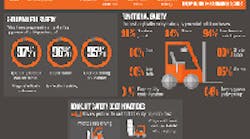Economists use many indicators to gauge fiscal health, but after covering last week’s huge ProMat show in Chicago, I discovered another one: new trade shows.
MHI made its contribution to this metric last year by introducing the Modex Show to this market’s mix of exhibitions. Its reason for being was to expand the scope of material handling beyond the four walls to encompass logistics. But during a press conference at last week’s ProMat, MHI announced a partnership with Reed Exhibitions to co-locate next year’s Modex with the U.S. premiere of Supply Chain & Transportation USA. This Reed event adds carriers, freight forwarders and third party logistics service providers to the mix of market offerings on display for U.S. supply chain managers.
MHI must be pretty optimistic about this market’s capacity to absorb another logistics event. During its ProMat press conference last week, MHI CEO George Prest presented the latest Material Handling Equipment Manufacturing economic forecast. The numbers support optimism. The U.S. can expect 6% GDP growth this year and 10% or better next year. Add on top of that MHI’s co-location announcement with Reed for next year’s Modex, and you can’t help but feel positive.
But isn’t there a danger that the logistics market has reached a saturation point when it comes to trade shows? Laurent Noel, industry vice president of transportation and logistics for Reed Exhibitions doesn’t think so. After introducing Reed’s supply chain event to the U.S. media at last week’s press conference, he told me during an offline discussion that it’s time for U.S. supply chain managers to think globally.
“Today you have to think multi-modal and you have to organize the proper tracking for following your goods, including creating the distribution centers to deliver quickly to consumers,” he said. “The specialists in transportation and in warehousing need to work together. The fact that supply chain managers are being included in board meetings proves there’s corporate recognition that a well done supply chain can increase productivity, reduce costs and be a corporate asset.”
But if supply chain managers are being called into board meetings to present opportunities, they’d better also be prepared to document threats. This morning’s Wall Street Journal had a perfect example. Seven more workers lost their lives in another Bangladesh factory fire. We commented on another fire that happened in that country late last year, involving a plant that was subcontracted by a supplier to Walmart and Sears. That one killed 100 workers. In our commentary we said the multiple tiers in global supply chains tend to lend manufacturers and retailers some level of deniability in such situations.
No American retailers were associated with this latest tragedy, but a Spanish clothing retailer, Inditex, was. As a company that sources globally, it had to be aware of that last incident, so ignorance is becoming a tougher defense. And although there may be a couple links separating them from the irresponsible plant that allowed this tragedy, any supply chain manager worth his mettle should be drafting a plan about now to help Inditex deal with any potential human and economic repercussions.
If next year’s co-located Modex/Supply Chain & Transportation USA events can help make such a job a little easier, I’d say this market should open wide for it.



